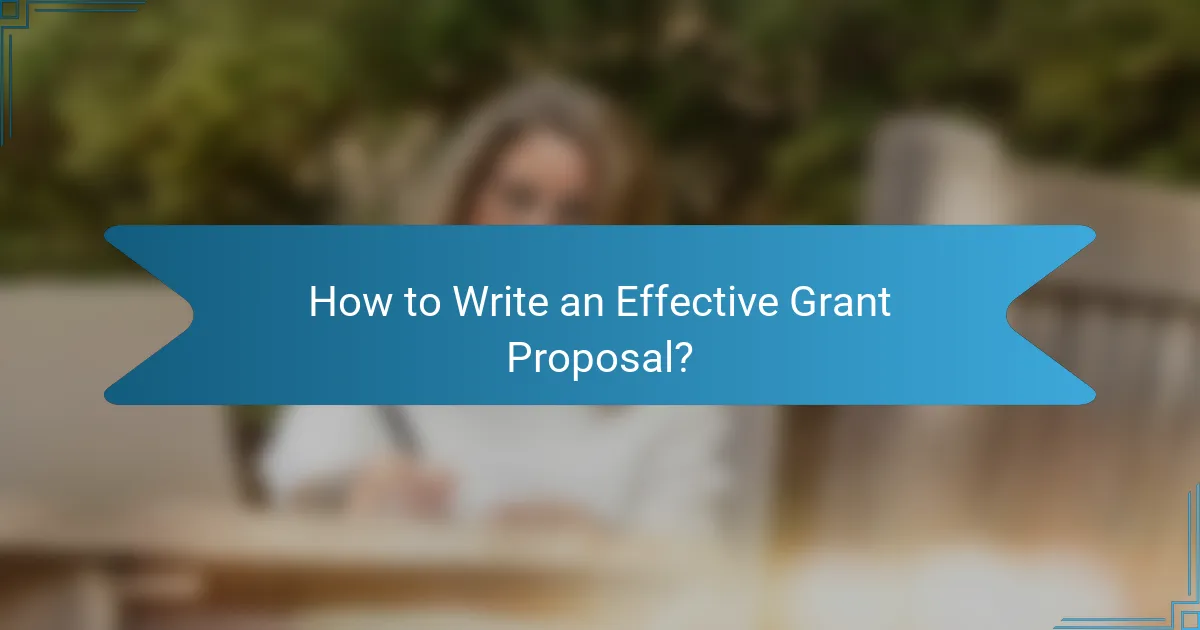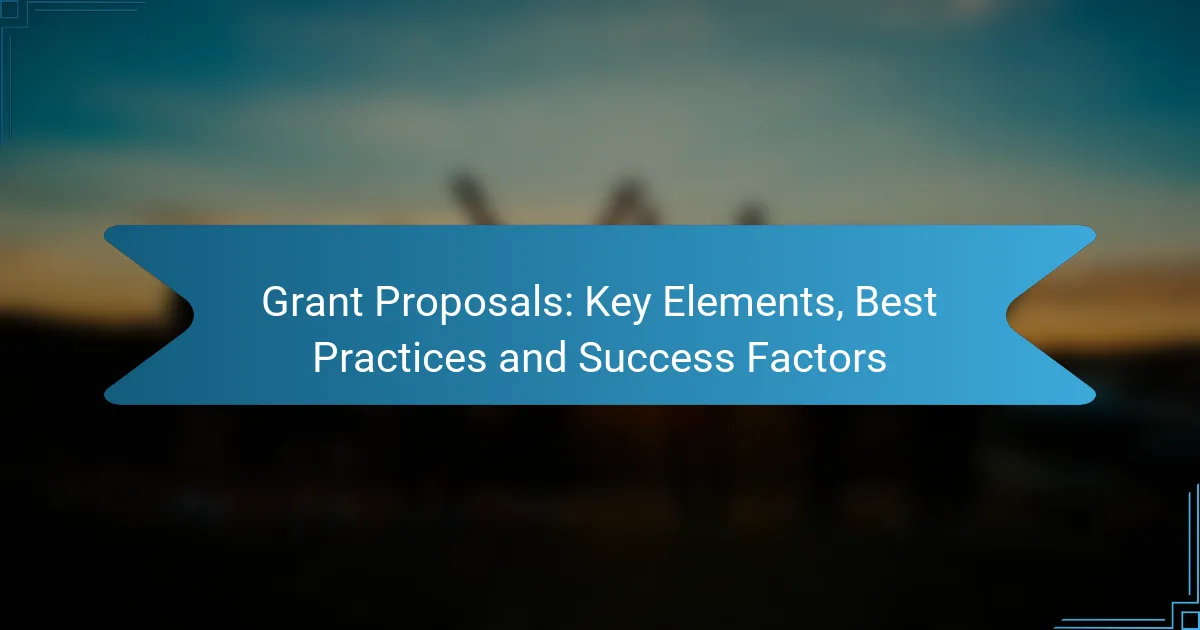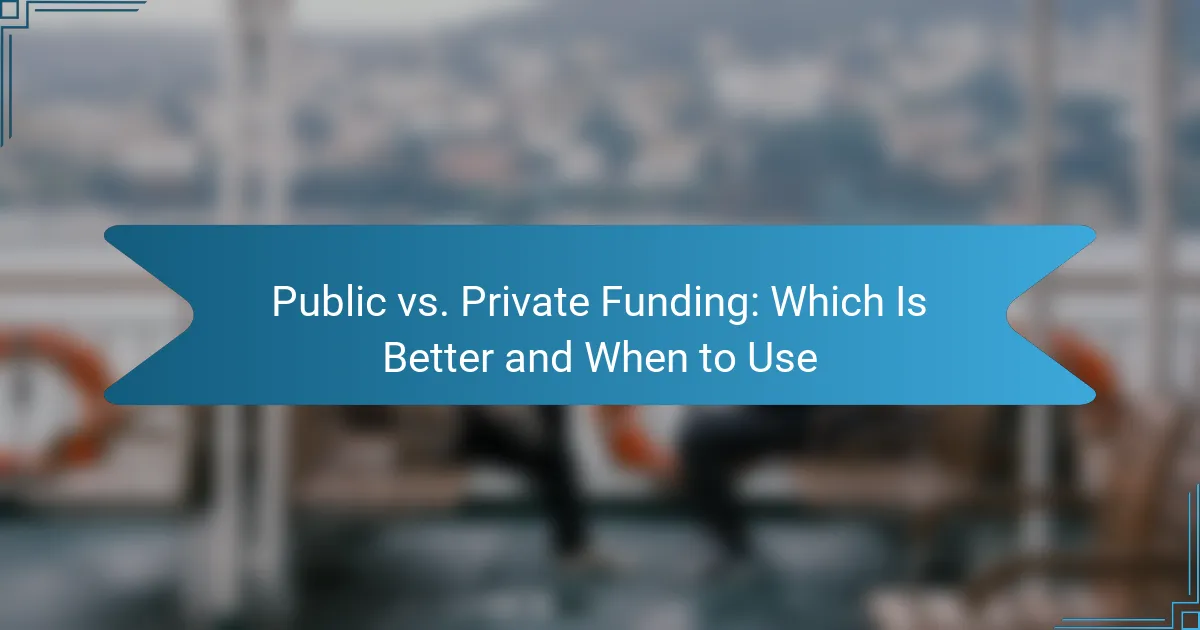Grant proposals are essential tools for securing funding, and they must include key elements such as an executive summary, a statement of need, and a detailed project description. To be effective, proposals should clearly articulate project goals and align with the priorities of potential funders. By adhering to best practices, applicants can improve their chances of success in the competitive landscape of grant funding.

What Are the Key Elements of a Grant Proposal?
The key elements of a grant proposal include a clear executive summary, a compelling statement of need, a detailed project description, a justified budget, and a robust evaluation plan. Each element plays a crucial role in persuading funders to support your project.
Executive Summary
The executive summary provides a concise overview of the entire proposal, summarizing the project’s purpose, goals, and the funding amount requested. It should capture the essence of the proposal in a way that entices the reader to learn more.
Focus on clarity and brevity, ideally keeping it to one page. Highlight the problem being addressed, the proposed solution, and the anticipated impact to engage funders right from the start.
Statement of Need
The statement of need articulates the specific problem or issue that your project aims to address. It should be backed by data and research to demonstrate the urgency and significance of the need.
Use local statistics or case studies to make your argument more compelling. Clearly define the target population affected by the issue, and explain how addressing this need aligns with the funder’s priorities.
Project Description
The project description outlines the proposed activities, timeline, and methodologies. It should detail how the project will be implemented and the roles of key personnel involved.
Include specific objectives and measurable outcomes to show how success will be evaluated. A well-structured timeline can help funders visualize the project flow and milestones.
Budget Justification
The budget justification explains how funds will be allocated and why each expense is necessary for the project’s success. It should align closely with the project description to ensure transparency.
Break down costs into categories such as personnel, equipment, and materials. Providing a rationale for each expense can help convince funders of the project’s feasibility and your financial responsibility.
Evaluation Plan
The evaluation plan describes how the project’s effectiveness will be measured and assessed. It should outline the methods for collecting data, analyzing results, and reporting findings.
Include both formative and summative evaluation strategies to ensure continuous improvement and accountability. Specify who will conduct the evaluation and how the results will be used to inform future projects or funding requests.

How to Write an Effective Grant Proposal?
Writing an effective grant proposal involves clearly articulating your project’s goals, demonstrating its significance, and aligning with the funding source’s priorities. A well-structured proposal not only outlines your objectives but also showcases your organization’s capacity to deliver results.
Research Funding Sources
Identifying the right funding sources is crucial for a successful grant proposal. Focus on organizations that align with your project’s mission and objectives, such as government agencies, foundations, and corporate sponsors. Tools like grant databases and funding opportunity announcements can help streamline your search.
Consider factors such as the funding amount, application deadlines, and eligibility requirements. Prioritize sources that have a history of supporting similar projects to increase your chances of success.
Follow Guidelines
Every funding source has specific guidelines that must be followed meticulously. These guidelines typically include formatting requirements, page limits, and submission procedures. Adhering to these details demonstrates professionalism and respect for the funder’s process.
Make a checklist of all requirements and ensure that your proposal addresses each one. Common pitfalls include exceeding page limits or failing to include necessary documentation, which can lead to disqualification.
Engage Stakeholders
Involving stakeholders early in the proposal process can enhance the quality and relevance of your project. Engage individuals or groups who have a vested interest in the project, such as community members, partners, and experts in the field. Their insights can help refine your objectives and strengthen your proposal.
Consider forming a proposal development team that includes diverse perspectives. This collaboration can lead to a more comprehensive understanding of the project’s impact and improve the overall quality of the submission.
Use Clear Language
Clarity is essential in grant proposals. Use straightforward language and avoid jargon to ensure that reviewers easily understand your project. Clearly define technical terms and concepts, especially if your audience may not be familiar with your field.
Organize your proposal logically, using headings and bullet points to break up text and highlight key information. This approach not only improves readability but also helps reviewers quickly locate important details.

What Are the Best Practices for Grant Proposals in the UK?
Best practices for grant proposals in the UK involve understanding funder expectations, clearly defining project goals, and ensuring transparency throughout the application process. By following these guidelines, applicants can significantly enhance their chances of securing funding.
Tailor Proposals to Funders
Each grant proposal should be customized to align with the specific interests and priorities of the funding organization. Research the funder’s mission, previously funded projects, and application guidelines to ensure your proposal resonates with their objectives.
For instance, if a funder emphasizes community engagement, highlight how your project will involve local stakeholders and address community needs. This tailored approach demonstrates your commitment and increases the likelihood of approval.
Include Measurable Outcomes
Clearly defined and measurable outcomes are essential in grant proposals. Funders want to see how their investment will lead to tangible results. Outline specific goals and the metrics you will use to evaluate success, such as participant numbers, project milestones, or community impact assessments.
For example, instead of stating “we aim to improve literacy,” specify “we will increase literacy rates by 20% among participants within one year.” This clarity helps funders understand the potential impact of their funding.
Maintain Transparency
Transparency is crucial in building trust with funders. Provide a clear budget that outlines how funds will be allocated, and include any potential risks and how you plan to mitigate them. This openness shows that you are responsible and accountable.
Additionally, consider including a timeline for project implementation and reporting. Regular updates on progress, challenges, and financial expenditures can further enhance transparency and keep funders informed throughout the project lifecycle.

What Are Common Mistakes to Avoid in Grant Proposals?
Common mistakes in grant proposals can significantly hinder your chances of success. By addressing clarity, adherence to guidelines, and budget realism, you can enhance your proposal’s effectiveness.
Lack of Clarity
A proposal lacking clarity can confuse reviewers and lead to rejection. Ensure that your objectives, methods, and expected outcomes are articulated in straightforward language.
Use clear headings and bullet points to break down complex information. Avoid jargon unless it is essential, and always define any technical terms you must use.
Ignoring Guidelines
Each funding opportunity comes with specific guidelines that must be followed. Ignoring these can result in automatic disqualification, regardless of the proposal’s quality.
Carefully read the funder’s requirements, including formatting, page limits, and submission procedures. Create a checklist to ensure all guidelines are met before submission.
Overly Ambitious Budgets
Submitting an overly ambitious budget can raise red flags for reviewers. Ensure your budget is realistic and justifiable based on the project’s scope and objectives.
Break down costs into categories like personnel, materials, and overhead. Use historical data or similar projects as a reference to create a reasonable budget that aligns with funding norms in your field.

How to Evaluate the Success of a Grant Proposal?
Evaluating the success of a grant proposal involves analyzing feedback from funders and assessing the project’s outcomes. These evaluations help determine the effectiveness of the proposal and identify areas for improvement in future submissions.
Review Feedback from Funders
Gathering feedback from funders is crucial for understanding why a proposal was successful or unsuccessful. Funders often provide insights on the clarity of objectives, budget appropriateness, and alignment with their priorities. Pay attention to both positive comments and constructive criticism.
Consider creating a systematic approach to document and analyze this feedback. For example, categorize comments into strengths and weaknesses, which can guide revisions for future proposals. This practice not only improves your chances of success but also builds relationships with funders by demonstrating responsiveness.
Assess Project Outcomes
Assessing project outcomes involves evaluating whether the goals outlined in the grant proposal were achieved. This can include measuring quantitative results, such as the number of beneficiaries served, as well as qualitative impacts, like community feedback. Establishing clear metrics beforehand can simplify this assessment.
Utilize tools such as surveys, interviews, and performance metrics to gather data on project effectiveness. Regularly reviewing these outcomes against the initial objectives allows for timely adjustments and enhances the credibility of future proposals. Remember to document lessons learned and share them with stakeholders to foster transparency and continuous improvement.



